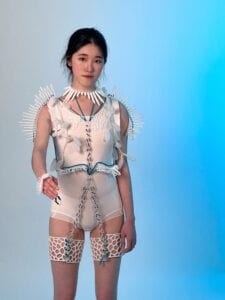
Project Title:
Ride with the Wave
Team Members:
Chanel & Luna
Description & Concept:
The interactive garment serves as a conduit, allowing wearers and observers to intimately grasp the multifaceted experience of bipolar disorder. Through synchronized breathing, it mirrors the ever-shifting landscape of manic euphoria and depressive depths of bipolars. Within this intricate dance, the wearer’s longing for connection waxes and wanes, and the interactions are both solace and struggle. Would you be willing to give them an embrace of compassion?
这件互动服装邀请穿戴者和观众密切地感受双相情感障碍者的生活。在同步呼吸之间,它反映了躁郁症者不断处于变化的情绪曲线。穿戴者对于联系的渴望时断时续,互动时而产生慰藉,时而也是挣扎。你愿意拥抱他们,和他们同频呼吸吗?
Research & Development:
- Main Idea
What does it feel like to engage in a social life as a person with bipolar disorder? The design of the clothes, with its pneumatic pumps, lights, and sensors, codes the bipolar emotional cycle into the interaction process. The pneumatic device sucks and pumps in air at a high pace during the mania episode, and the lights turn white and yellow when the wearer gets in touch with others, suggesting a high emotional need for companionship. When it goes to the depression episode, the lights turn sharp red when the sensor is pressed, and the pneumatics would stop working. However, if the wearer is given a hug, the presser sensor on their back would be activated, and the pneumatic device restarts working with the lights showing warm yellow. In a nutshell, the garment utilized multiple interactive devices to help foster a better understanding of bipolar disorder and call for love and care for bipolars with a simple hug.
- Research, Inspiration & Experiments
We’ve actually illustrated these inspirations and experiments in our proposal blog. I will also include some of them here. For more detailed information, you can click here.
-
- Research on the concept: What BD is
The idea behind “BD” originated from Chanel’s interactions with a friend who has bipolar disorder. We’re generally aware of the basic conditions of this disorder and its two common emotions: mania and depression. Subsequently, we researched bipolar disorder’s emotional curve charts and delved into psychology books to understand the different social needs and desires of individuals with bipolar disorder during various emotional periods. Our concept is based on the evolving social needs of individuals with bipolar disorder during different emotional states.
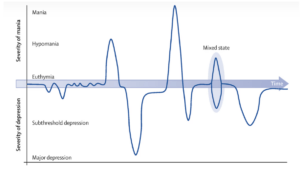
[Periodic curves of the emotion of bipolar, by Iria Grande, Michael Berk, Boris Birmaher, Dr Eduard Vieta]
Later on, we realized that categorizing these emotional changes solely as unique to bipolar disorder, or assuming that bipolar disorder’s emotional fluctuations perfectly align with emotional curve charts, is somewhat one-sided. The varying social needs resulting from emotional changes are actually shared by all humans, and each person’s emotional fluctuations are unique. This realization broadened our project into a larger, more universally meaningful concept, and it also respects the diversity of human experiences.
-
- Research on other BD art works
Before starting our design work, we also conducted some research on artwork related to bipolar disorder, as well as surveys on fashion clothing representing BD. We noticed that these artworks tended to depict the inner anguish of BD through static poses, without addressing the varying and changing interaction needs of individuals with BD in dynamic external settings. However, we believe that understanding the emotional changes in BD and the different interactions needed is crucial in helping people better interact with those affected by BD. Therefore, the focus of our project is on the differences in emotional states and the required interactions, which we believe can be further explored through fashion based on previous works.
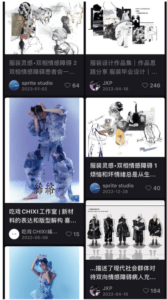
[A screenshot from Little Red Book when searching “bipolar disorder fashion”]
-
- Research on mechanisms and experiments
- Scissor Mechanism
The idea for the Scissor mechanism was inspired by a device we created in our first group work assignment using rubber bands and nails to demonstrate self-constraint, which we aimed to convey through this device along with the sensation of inflation like a pump. We were influenced by videos showcasing expandable mechanical arms and began experimenting with creating this type of scissor mechanism. In our project proposal documentation, you can see that we initially attempted to make this device using cardboard and toothpicks. Later on, we switched the materials from cardboard to acrylic sheets and replaced the toothpicks with bendable nails. We also experimented with fixing and pulling at different positions to achieve the desired expandable effect.
-
- Pneumatics
For the pneumatic inflatables, we had the following attempts: Silicone ➡️ Rubber fingertips ➡️ Silicone 2nd trial ➡️ “Rubber fingertips Pro”.
First, We made a silicone mold together under the guidance of Marcela in her remaker space. The process was divided into two parts, preparing the silicone (mixing A & B) and pouring the silicone into the laser-cut mold.
Later, we tried out using the fingertips from the rubber gloves that we bought for previous assignments, and they worked very well in terms of imitating breaths, plus they were much easier to prepare and lighter to wear.
However, we didn’t want to give up on silicone that quickly because we thought the material could create a better and more exaggerated visual effect. The next day after the presentation, we had a second trial. Inspired by a project that made a breathing skin, we decided to laser cut a mold by ourselves and experiment with something similar. Chanel modeled and printed a few parts as the air layer, and I laser cut a square box as a silicone container. It turned out that, though the second layer was very thin, it was still very hard to get the 3D-modeled part out of it after it was done. We then switched to using baking paper as the air layer. Since the connecting parts were narrow and some were accidentally stuck together, it was a bit hard for the air to go through, and the visual effect at the end was not great.
After two failed attempts, we went back to rubber fingertips. We tried to add more of them to test how many could two motors supply, and add variables like different textures and colors of rubber gloves. We also tried with the different hose connectors to see which worked better. We tried to build more with 3-hole hose connectors right after our failed attempts with silicone. It worked well. Later during the spring break, we bought the Y-shape hose connectors and 4-hole hose connectors. And we built a super big and long one with them. However, the effect is not that good. We then divided them into several parts. Then they worked better.
Thus, we realized that instead of building a very big one, we can build smaller ones and placing them on different parts of our bodies. (And we indeed followed this discovery in our final work!)
- Working Process:
- Pneumatics
Most of the working process of pneumatics has been embedded in the experimental process described above. We ultimately decided to use two sets of pumps to support the movement of two pneumatic chains. These are located on the left and right sides of the chest. They are shaped very much like our lungs and produce different inhaling and exhaling effects depending on the stage and interaction.
We used silver thread to wrap around the taped connections between the fingertips and tubes to cover the tape and make the garment more aesthetically pleasing.
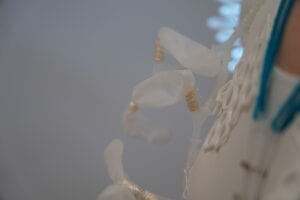
- 3D printings:
- 3D emotional waves:
The 3D emotional waves on the shoulders are developed based on Luna’s grasshopper exercise. We feel that this kind of disorderly feeling resembles the fluctuations in a person’s emotions. Luna slightly enlarged and widened the grasshopper pattern from that exercise, allowing room for NeoPixels to pass through the two waves on the shoulders. As for the two waves at the waist, we felt the need for them to complement each other vertically, and we particularly liked the projection of the 3D emotional waves on the white fabric under the lighting at the waist. Since we wanted the audience’s visual focus to be on the upper part of the model’s torso while avoiding an empty lower part, this solution served both purposes. The 3D emotional wave pattern at the waist is also connected to the blue line running through the scissor mechanism, helping to secure the scissor mechanism in place.
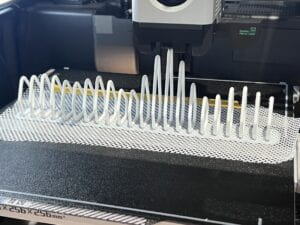
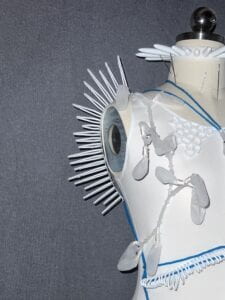
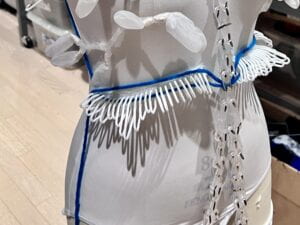
-
- Leg rings:
We wanted to create something on the legs to echo the pneumatics around the upper body. Chanel generated the pattern by applying voronoi in Grasshopper to the alveoli in the lung. Some attracting points were added to create holes with different sizes. Eventually, the scissor mechanism and the leg rings were attached to each other. The leg rings also serve as two anchor points for the scissor mechanism to work when the wearer walks.
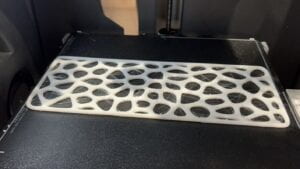
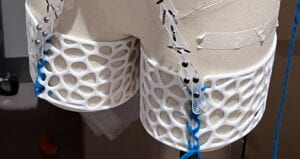
-
- Choker:
The making of the choker follows Chanel’s weekly assignment for grasshopper exercise. Chanel designed different heights of circular cones in a line using graph mapper in Grasshopper to represent the highs and lows of bipolars. The choker in a way is a defense mechanism of the wearer against danger from the outside, but it sometimes also suffocates the wearer, just like what their emotional cycle does. When the wearer is moving their head, the cones on the choker also wave with the move. Some magic stickers were used to adjust the radius of the choker.
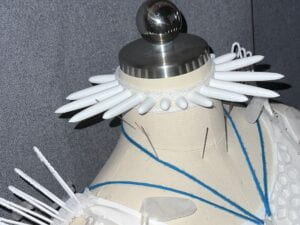
-
- Decorations on Chest:
The decoration on the chest is developed from Luna’s Voronoi exercise. The pattern also complements other patterns we created to evoke a sense of wave-like changes. It fills the empty space on the chest, and according to our friend Ting, she mentioned that she feels this decoration makes our creation look like a piece of clothing now (we’re not sure whether to cry or laugh 😬).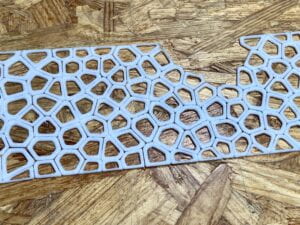
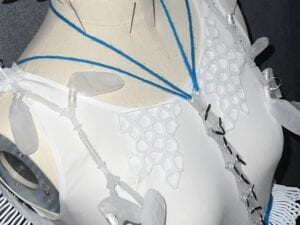
- Laser cuttings:
- Scissor Mechanism:
The scissor mechanism was developed based on the prototype we presented in the proposal presentation. We extended the mechanism, originally designed to hang around the neck, and connected it with a forked design to leg loops, altering its operation. We aim for this mechanism to simulate inflation when the model walks, giving a sense of pumping air, while also conveying a feeling of constraint. Initially, we intended for the model to extend and retract the mechanism by pulling a cord around the neck. However, due to the length of our scissor mechanism and its connection to both leg loops, this proved difficult and cumbersome to operate manually. Therefore, we transformed the structure into a mechanism that adjusts naturally based on body movement, eliminating the need for manual pulling. We ultimately secured the midpoint of the scissor mechanism onto two 3D wave decorations at the waist, leaving the upper part of the mechanism stationary for decoration purposes only, while the lower part connected to the legs extends and retracts as the person walks.
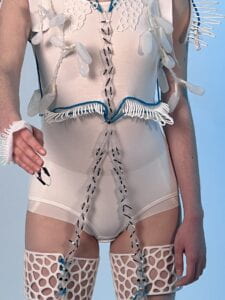
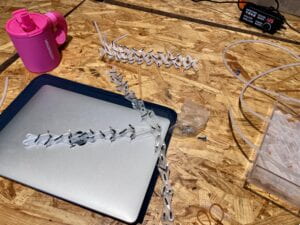

-
- Big funny box:
Okay, regarding the criticism about the oversized “big funny box,” we have a few points to make. This box was meticulously designed and constructed by Chanel and Luna after carefully measuring all the electronic devices we needed to hide and store. Luna felt that Chanel’s Voronoi pattern on the legs was particularly suitable for adapting into decorative patterns on the front and top of the box, as well as for the patterns on the dividers between each layer. This served two purposes: it added decorative functionality and allowed us to layer and organize the interconnected electronic devices while allowing wires to pass through the hollowed-out holes to connect them. Additionally, the holes helped to some extent in keeping the wires organized and preventing significant shifts in their positions. We started by measuring the dimensions of the box—its length, width, and height. Then Luna used Makercase to create a model of the box we wanted. After importing it into Adobe Illustrator, we used the image tracing tool to turn Chanel’s Voronoi pattern into a pattern that could be combined with the boards inside the box. After going through a series of processes, including laser cutting, assembly, and gluing, our big funny box was completed. Initially, we considered 3D printing the box, but it was too material- and time-consuming, making it impractical. That’s why we decided to use laser cutting to construct the box. Please refrain from mocking it further. 🥲Although it’s big and funny, it carries a significant load. Without it, our efforts would be in vain.
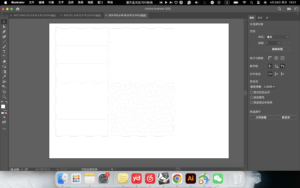
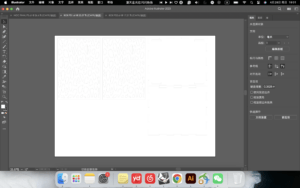
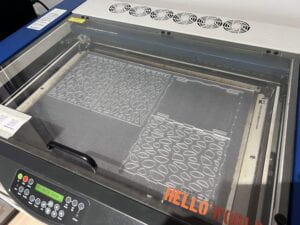
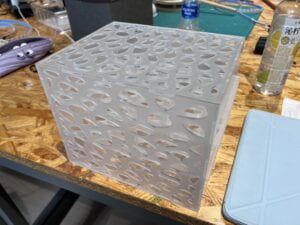
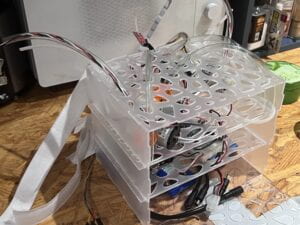
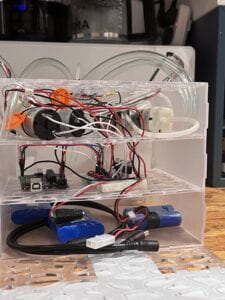
- Circuit building & decoration of electronic elements:
-
- Circuit building
-
We used two breadboards (later Marcela helped me put everything into one breadboard) and a few alligator clips for the first prototype, and later on we replaced all the alligator clips with soldering wires and soldered the pumps and the pressure sensors with the wires. The circuit can be mainly divided into three parts, the pumps (in total, there are 6), the neopixels, and the two sensors. The two sensors go back to two pins on the arduino pad, and send signals to the lights and pumps. The circuits broke several times due to different reasons (didn’t use the right batteries; the arduino pad broke; the sensors broke…), and a lot of thanks to Marcela who helped us rebuild and debug along the way. The circuits were eventually moved to the box, with the wires going through the holes on the separators that we laser cut. The first layer contains the 6 pumps, the second the arduino pad and the bread board, and the third three batteries (one 12v battery for the pumps, and 2*5v batteries for the lights and the sensors)
-
- Decoration of electronic elements
To echo with our theme, we purchased quite a few medical tubes to put the circuits in. Eventually, the box looks like a breathing machine, with a lot of tubes coming out that are connected to different body parts of the wearer. In addition, we used a few leftover tubes to decorate the box. In addition to that, we intended to not let the sensor on hand not that obvious so we made a bracelet with similar elements on our clothes to hide it.
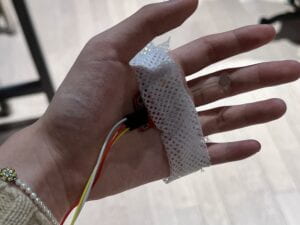
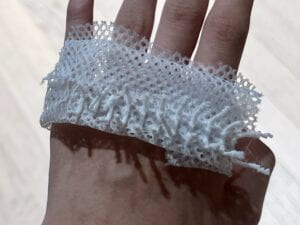
- Coding:
The coding is built based on the different functions and effects we want to showcase in different emotional stages. How code is interconnected with our concept is commented on in the coding: click to see
- Model & Rehearsal & Some Sidelights of Runway:
A few hours before the runway, we did the rehearsal with our model Claire, including when to clap hands with the audience, when to stop and pose, as well as when for us to hug her. Since our project was pretty much time-based (we set time periods for each stage/episode), it was essential for us to rehearse ahead of time and let the model be aware of what she would be doing on the runway. It turned out very well, and the audience enjoyed interacting with our model (event after the runway show haha).
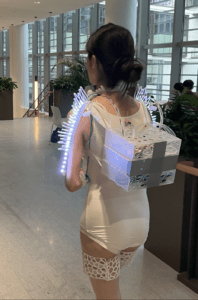
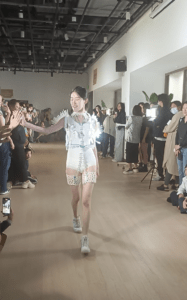
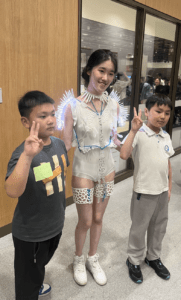
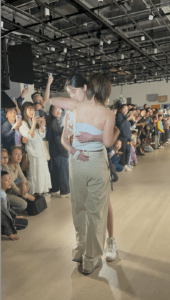
- Finished Work & Runway:
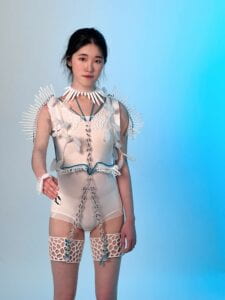
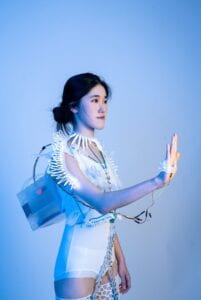
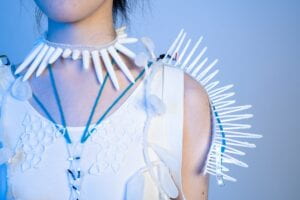
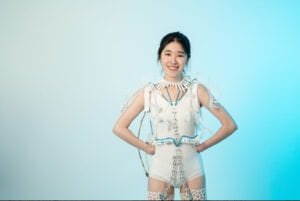
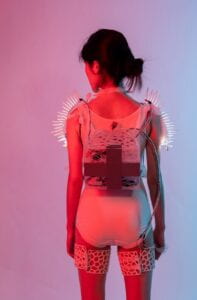
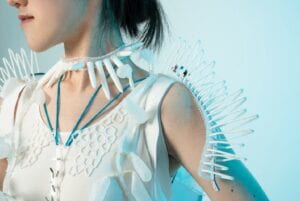
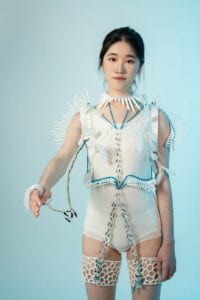
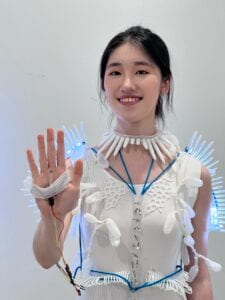
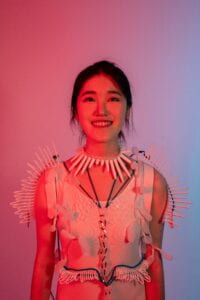
Model: Claire Yang
Photo Taking: Ken & Luna
DocumentationVideo: Chanel (Lots of great ideas embedded inside! Please take a look😆!)
- What each team member did:
- Idea Generating & Plan Making: Chanel & Luna
- Coding: Luna, partially Chanel, helped by Marcela
- Circuit: Chanel, partially Luna, helped a lot by Marcela
- Scissor Mechanism: Luna
- Fingertip pump building: Chanel & Luna
- Leg ring: Chanel
- 3D wave on shoulders and ribs: Luna
- Decoration on chest: Luna
- Box making: Outer shape and layers designed by Chanel & Luna; patterns adapted from Chanel’s leg ring design, converted to patterns on the box by Luna with Adobe Illustrator & Makercase
- Choker: Chanel
- Bracelet for sensor: Chanel & Luna
- Countless measuring, 3D printing, sewing, and assembling: Chanel & Luna
- Stuff purchasing: Chanel & Luna
Conclusion:
Chanel’s conclusion is so good in illustrating our work’s value to society and the cultural and societal metaphors embedded in our project. Mine might not be that professional and deep, but please take your time to read through the long text, and it will finally go back to our theme “Ride with the wave”, which is rooted in our initial concept of illustrating BD’s social life but ends up in a much broader concept that involves everyone’s emotion and interaction inside the society based on my feelings and interpretations.
The final result of this project truly satisfies us. We achieved all the effects we wanted, despite burning out circuits and electronic components multiple times.
We spent a lot of time on this project, anticipating a busy final period. We started feeling anxious about it right after spring break and continued refining, experimenting, and optimizing the project. Many things frustrated us during the process, like the easily damaged 3D modeling. Chanel and I often took turns monitoring the 3D printer, spending entire days because of numerous mishaps. We sought Dalin’s advice countless times and were guided by Andy’s enthusiasm. The coding aspect was unsettling; despite being an inter-lab student, I mainly handled circuitry, fabrication, and decoration in my inter-lab experiences. I started coding our project early on, knowing I wouldn’t get it right the first time, and without coding, we can’t test the circuit. I encountered “delays Vs millis” usage problems and all kinds of problems with the colors of neopixels. Fortunately, starting early and Prof. Marcela’s timely assistance helped us got through all these difficulties. The most daunting part was the circuit. Chanel initially tackled it, but it was challenging and prone to mistakes when done alone. Initially, I hesitated to modify a circuit I hadn’t built, fearing it would worsen things. However, I realized we needed two people to cross-check each other while building the circuit to avoid errors and pin misplacements. I lost count of how many times I sheepishly sought help from Marcela, Rudy, Andy, and others regarding circuitry correctness, battery use, borrowing batteries, and why our Arduino wouldn’t connect to the computer. One vivid memory was three Spanish-speaking professors watching our circuit and speaking in English (I don’t know why that struck me!). Each connection of circuitry and coding was nerve-wracking, facing it alone felt daunting, so we mostly worked in pairs, with two computers taking turns, often collapsing together. Luckily, everything eventually worked out.
We initially used a remote sensor on the hand, but before the final presentation, we switched to a pressure sensor for better sensitivity and stability in interactions. Here, I must commend and appreciate my teammate Chanel’s excellent soldering skills; she’s exceptionally skilled, and I deeply admire and appreciate her.
Throughout our work, there were countless moments of despair and breakdowns, but we also encountered many compliments from nice friends, classmates, and even strangers. I remember one night at the end of April; we had attached many 3D-printed decorations to the clothes. Chanel had to leave early, and as I was clearing the table, a classmate from another course asked what it was, saying it looked cool. That moment made me unexpectedly happy. When I stepped out of the storage room at the Fab Lab and saw the clothes on our makeshift mannequin, I thought, “Wow, it looks really good.” I immediately sent a photo to Chanel, and she agreed. We said to each other that this was indeed much better than our midterm work, but we had to stay humble until the end. We had to maintain modesty and caution in the face of questions about our decoration and mechanism. We rarely received positive feedback from external sources, but we motivated each other because we knew our own satisfaction mattered most.
In the end, everything worked. When Chanel wore the outfit for our Wednesday class, I took a picture of her. I said, “Seeing you standing there among the crowd gives me the feeling of suddenly spotting my favorite idol in an idol group.” Before the runway, Chanel and I speculated if Prof. Inmi, who once praised our work in ComLab, would come to see the runway. We were nervous; we didn’t want to embarrass ourselves. I felt like crying at that moment. We were the first to walk the runway, and although no one wanted to go first, I felt our team wanted to. It was a display of confidence, and we deserved to go first. After the runway, as soon as we stepped out, Yelena cried because there were minor glitches in her work right before the runway. We all gathered around her to console her, and we all ended up crying because we related so much — we had worked so hard, why were there still small mistakes? Not everything is perfect. One second I was taking photos of everyone consoling her, the next second, Chanel and I were crying too. Andy asked Xiangyi and Maelyn why we were crying, and they explained to Andy that it was tears of joy. Andy remarked, “Well, it doesn’t look like happy tears.” I find it hard to summarize if our tears were happy, sad, or simply a release; they encompassed so much — from being moved by our dedication to our work, and grateful for the help from many teachers, professors, and friends during our moments of breakdown, to acknowledging the sadness and hardship we faced throughout the course (honestly, though it’s hard to say, this has been the class where I’ve experienced the most pain, despair, and breakdowns so far). I was also excited because our work turned out really well, the effects were great, and we were especially satisfied. We felt like we had turned things around in our own world. The once pitiable Chanel and Luna had finally seen the light of day. In simple terms, to quote a friend’s summary: we were so awesome that we cried.
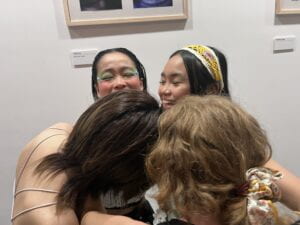
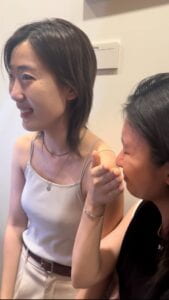
Such complex emotions and tears ran through our entire project and this class. We coexisted with different waves all the time, sometimes feeling like we were ridden by the waves, sometimes feeling like we were the ones riding the waves. I guess that’s what it means to “ride with the wave.” All of this has become past waves now, but they have definitely left deep marks in our hearts, creating our wavy heart rate as we look back. At this moment, a wave of emotions floods me, and I feel like crying again. I want to thank Prof. Marcela for her constant help and thank Chanel for sticking with me. I love you all, I love our effort, and I love “riding with the wave.”
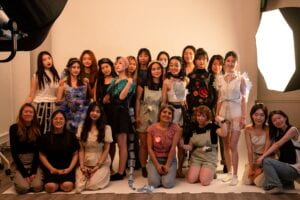
Leave a Reply